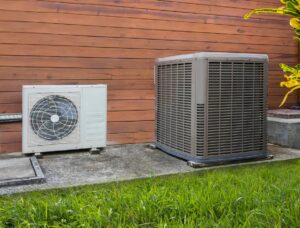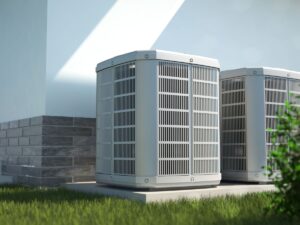Heat Pump Installation & Services in Chula Vista, СА
Boilers operate in a manner akin to a household kettle. They feature a combustion chamber where air combustion takes place through the ignition of gas or oil. The resultant hot air is passed through an exchanger to convert it into thermal energy, subsequently utilized for heating water.
Heat pumps, on the other hand, also employ an exchanger, but a critical distinction is that they do not rely on a combustion chamber. Instead of burning oil or gas, a heat pump sources its thermal energy from natural elements, such as air, water, or the ground.

The gathered from these natural sources undergoes a series of compressions until it reaches a temperature sufficient to both your home and water. This thermal energy can then be disseminated through conventional radiators or underfloor heating systems.
The Installation of a Heat Pump as an Alternative to a Gas Boiler
A typical air-to-water heat pump running cost amounts to 4 cents per kilowatt-hour (kWh) of it, whereas a gas boiler incurs an 8-cent cost, and an oil boiler approximately 15 cents. Given our daily consumption of thousands of kWh, the savings considerably reduce our annual utility expenses. An additional advantage lies in the shift from fossil fuels to sustainable sources. Since heat pumps continually recycle their process to capture more energy, there is a constant transfer of energy into this, leading to an approximate generation of up to 3 kW of energy for every 1 kW of electricity used.
SEAI Grants for Heat Pump Installations
The Sustainable Energy Association of Ireland (SEAI) provides substantial grant support for the installation of heat pumps in buildings constructed prior to 2011, serving as residential and commercial properties. Initially, you must engage an advisor to assess your building’s suitability for a heat pump installation, incurring a cost of €200 which the SEAI will cover. The advisor employs a highly specific heat loss indicator.
This loss indicator evaluates factors like the quality of your insulation and the airtightness of your home. If your dwelling experiences excessive heat loss, you may need to implement changes before installing a heat pump. This might encompass the installation of triple-glazed windows, additional insulation, or rectifying any minor openings that could be causing drafts within your structure.
When should I hire an air source heat pump installer during my construction project?
It is advisable to bring in an air source heat pump installer as early as possible in the project. Numerous components require installation, and various other trades also need to install their respective products.
It is crucial to ensure that all the equipment can be accommodated in the plant room without conflicts with other services or structural elements. Additionally, it’s important to plan the distribution pipework and wiring routes carefully to prevent any interference with existing systems.
What Does an Air Source Heat Pump Installer Do?
The role of an air source heat pump installer encompasses various tasks. Firstly, they are responsible for the design and specification of the system, determining factors such as heating capacity, equipment placement, distribution networks, and user interfaces like room thermostats.
In addition to the design aspect, they physically install the system. It’s crucial to note that in the case of existing properties, some aspects like repairing decorative work are typically not part of the installation process.

Once the installation is complete, the installer of Accord Air in Chula Vista, CA commissions the air source heat pump system. They provide a detailed handover to the homeowner, explaining how the system functions. Some installers may even offer maintenance packages and ongoing support after installation.
Moreover, it’s important to consider accessibility for maintenance when choosing a location. Ideally, you should position the heat pump at ground level rather than on a rooftop. However, if space constraints make this impossible, a flat roof remains a viable option.
In accordance with Planning Permission regulations, air source heat pumps must be situated at a minimum distance of one meter from the property boundary. For those opting to install these pumps on a flat roof, it’s equally essential to maintain a one-meter distance from the roof’s edge.
Is it Possible to Self-Install an Air Source Heat Pump?
Putting in an air source heat pump isn’t typically a task for the average do-it-yourselfer, but there are certain aspects of the pipework that a skilled DIY enthusiast might be able to handle once the system has been properly designed.
Applying insulation to the pipes could also be within the capabilities of a DIY individual, but it’s crucial to seek comprehensive guidance from a certified engineer of Accord AIR in Chula Vista, CA before undertaking any part of the installation process on your own.
